For the scholar, student, and
interested reader...
Subjects
Native American
History & Culture
The Early Frontier
Colonial & Indian Wars
The Missions
Indian Languages
Explorers &
Pioneers
American Dialects
|
American Indian Languages
Delaware
Indian Language of 1824
by C. C. Trowbridge
edited by James A. Rementer
In 1823, a
man named Charles C. Trowbridge went to Indiana Territory on an
assignment from Governor Lewis Cass of the Michigan Territory. His
mission was to obtain the answers to a list of questions pertaining to
the Lenape or Delaware language. After only two and a half months,
Trowbridge collected over 280 pages of handwritten information, making
the first full-fledged treatment of Southern Unami, the dialect spoken
by the two groups still existing in Oklahoma today. This is the dialect
of Lenape that was spoken in the southern half of New Jersey,
southeastern Pennsylvania, and Delaware.
After almost two centuries, Delaware Indian
language scholar James A. Rementer has now edited and published
Trowbridge's extremely thorough study in full. With well over a hundred
pages devoted to verb forms alone, and extended word-by-word analyses
of texts such as the Lord's Prayer and common phrases, Trowbridge's
work serves not only as a detailed grammar but also as an invaluable
cultural record from a time when the Lenape community was on its
journey from the Mid-Atlantic toward the west. Rementer's extensive
introductory material puts in context the historical forces that went
into producing this text, with a biography of Captain Pipe, one of
Trowbridge's main Indian informants. Contributions by Lenape scholar
Bruce Pearson and Timothy Crumrin round out the picture with
biographies of Trowbridge himself and William Conner.
2011 ~ 314pp ~ hardcover ~ 978-1-935228-06-6 ~ $80.00
|
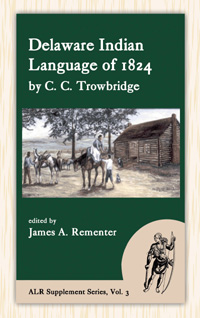
This title
qualifies for
a 10% discount when
ordered online
|
Sagard's
Dictionary of Huron
by Rev. Gabriel Sagard (1632)
edited by Dr. John Steckley,
Humber College
Recollect
Brother Gabriel Sagard's 144-page French-Huron dictionary, first
published in 1632, is one of the earliest dictionaries of any Native
American language and is the foundation of French missionary studies in
Iroquoian. This exhaustive new edition by renowned Huron scholar John
Steckley is a complete translation of this historic dictionary.
It begins with a thorough introduction, including
extensive notes on Huron linguistic variation and dialect differences,
featuring comparisons with other Iroquoian languages. This introduction
also breaks new ground in offering evidence of a trade language or
pidgin with a St. Lawrence Iroquoian component—the first definitive
evidence of the survival of that language since it was first
encountered by Cartier in the 1530s. The dictionary section is a direct
translation from Sagard's original text, featuring the original French
entry, a newly-added English translation, and then the corresponding
Huron phrase with added etymological and comparative analyses. Steckley
also complements Sagard's phrase-based arrangement with a complete
index to the over 230 Huron noun stems and 360 verb stems featured in
the dictionary—the first such indexing since the work's original
publication and an invaluable asset for detailed linguistic study of
early Huron. This edition also includes a bibliography and general
index.
2009 ~ 482pp ~ hardcover ~ 978-1-935228-02-8 ~ $95.00
|
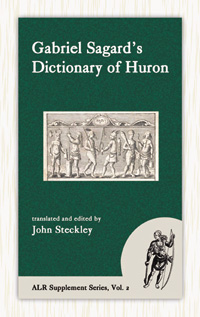
This title
qualifies for
a 10% discount when
ordered online
|
A
Synopsis of the Indian Tribes
Within the United States East of the
Rocky Mountains, and in the British and Russian Possessions in North
America
by Albert Gallatin (1836)
Originally
published under the auspices of the American Antiquarian Society in
1836, A Synopsis of the Indian
Tribes within the United States East of the Rocky Mountains, and in the
British and Russian Possessions in North America is a monumental
compendia of Native American language. Authored by statesman,
politician, and scholar Albert Gallatin (1761–1849), it is among the
finest systematic collections of Native American ethnology and
linguistics of its day. Containing invaluable information on some 81
tribes, the volume commences with four sections of introductory matter
giving an overview of the history of the various North American tribal
groups divided by geography (Section 1: Indian Tribes North of the
United States; Section 2: Algonkin-Lenape and the Iroquois; Section 3:
Southern Indians; Section 4: Indians West of the Mississippi). Section
5 covers general observations on social and cultural practices and
Section 6 begins an in-depth discussion of Indian languages.
Nearly half of this volume is made up of an
Appendix dedicated to grammatical notices and vocabularies from dozens
of tribes, including the Choctaw, Delaware, Micmac, Wyandot, Cherokee,
Eskimo, Massachusett, Sioux, and the various nations of the Iroquois.
Of particular note is the Comparative Vocabulary of Fifty-Three Nations
which presents a 60-page table of Native words and terms from tribes
such as the Ottawa, Nanticoke, Shawnee, Miami, Sauk, Osage, Omaha,
Natchez, Pawnee, and dozens of others arranged for easy comparison.
Also included is a further comparison of 16 Native languages including
Penobscot, Minsi, Nootka, Souriquois, Huron, Woccon, and others.
Finally, several short miscellaneous wordlists are included, such as
vocabularies of Blackfoot, Powhatan, Cayuga, Iowa, Crow, Shoshonee,
Cheyenne, Chinook, Caddo, Seneca, Mohawk, and many others.
2008 ~ 430pp ~ hardcover ~ 978-1-889037-80-0 ~ $85.00
|
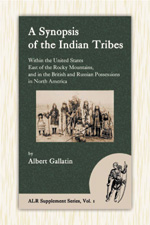
This title
qualifies for
a 10% discount when
ordered online
|
A
Vocabulary of the Nanticoke Dialect
by William Vans Murray; ed. Daniel G. Brinton (1796)
This volume
contains a list of some 300 words collected by Murray in 1796 along the
Choptank River on Maryland's Eastern Shore. It further contains
introductory remarks and annotation by linguist Daniel G. Brinton, who
provides words for comparison in a number of other Algonquin languages
including Lenape and Chipeway. This edition features an indexed listing
of Brinton's Algonquin comparisons in the appendix.
2005 ~ 46pp ~ paperback ~ 978-1-889758-61-2 ~ $17.95
American Language Reprint Series, Volume 1
For a complete listing of volumes in the ALR Series, click here.
|
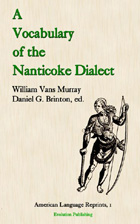
This title
qualifies for
a 10% discount when
ordered online
|
A
Vocabulary of Susquehannock
by Rev. Thomas Campanius Holm, et al. (1696)
Taken from
Campanius' Vocabula Mahakuassica,
this
volume
features
a
list
of
over
100
words
identified
as
the
only
known
vocabulary
of
Susquehannock
or Andaste, the Iroquoian language
spoken along the Susquehanna River in Maryland and Pennsylvania. The
edition follows the version translated by Peter S. Duponceau in 1834,
with added material from the original 1696 Swedish edition.
Discrepancies between the two editions are fully noted and catalogued
in the appendix. New to the second edition are additional fragments of
data: a single word from George Alsop's A Character of the Province of Maryland
(1666), another single word from Benjamin Smith Barton's New Views of the Origin of the Tribes and
Nations of America (1798) which purports to be from the
Susquehannock remnant at Conestoga, and incidental statements from the
Jesuits of Canada and the Moravian Bishop Commerhoff which are our only
evidence of the Iroquoian languages of Erie and Scahento, spoken in
Northern Pennsylvania.
2007 ~ 80pp ~ paperback ~ 978-1-889758-85-5 ~ $18.95
American Language Reprint Series, Volume 2
For a complete listing of volumes in the ALR Series, click here.
|

This title
qualifies for
a 10% discount when
ordered online
|
A
Vocabulary of the Unami Jargon
by Thomas Campanius Holm (1640)
From
Campanius' Vocabularium
Barbaro-Virgineorum, this volume features a
vocabulary of the Unami traders' jargon of Lenape-Delaware used along
the lower Delaware River, with over 500 entries plus dialogues and
speeches recorded in the 1640s. It follows theedition translated by
Peter S. Duponceau in 1834. Also included in this volume is William
Penn's word-list of the Pennsylvania Indians, which lists 17 words in
the jargon.
2005 ~ 62pp ~ paperback ~ 978-1-889758-63-9 ~ $18.95
American Language Reprint Series, Volume 3
For a complete listing of volumes in the ALR Series, click here.
|
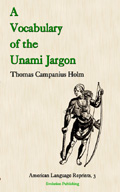
This title
qualifies for
a 10% discount when
ordered online
|
An
Ancient New Jersey Indian Jargon
by J. Dyneley Prince, ed. (1684)
From an
anonymous manuscript entitled the "Indian Interpreter" found in the
office of the Secretary of State at Trenton, New Jersey, this 261 word
vocabulary was taken from Salem County, NJ and is dated to 1684. This
version is reprinted from a 1904 article edited by J. Dyneley Prince,
who provides detailed explanations of the words and comparisons with
other Delaware/Lenape vocabularies. Also includes Gabriel Thomas' Discourses in the
Delaware Jargon (41 entries), and new to this
expanded edition are 23 terms from Peter Lindeström's Geographia
Americae.
2006 ~ 64pp ~ paperback ~ 978-1-889758-83-3 ~ $17.95
American Language Reprint Series, Volume 5
For a complete listing of volumes in the ALR Series, click here.
|
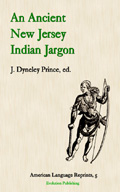
This title
qualifies for
a 10% discount when
ordered online
|
A
Dictionary of Powhatan
by William Strachey (1612)
This volume
represents the largest vocabulary ever collected of Powhatan --
approximately 1,000 entries compiled by William Strachey around 1612.
This edition is based on Major's 1849 printing of the British Museum
manuscript, with variant forms and extra words cited from the Bodleian
manuscript. Two supplementary word-lists of Virginia Algonquian are
also included: nine words from an anonymous relation of 1607 attributed
to Gabriel Archer, and 29 words from Robert Beverley's 1705 History and
Present State of Virginia. This edition also features an
introduction
by Powhatan scholar Frederic Gleach.
2005 ~ 107pp ~ paperback ~ 978-1-889758-62-0 ~ $19.95
American Language Reprint Series, Volume 8
For a complete listing of volumes in the ALR Series, click here.
|
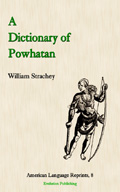
This title
qualifies for
a 10% discount when
ordered online
|
A
Vocabulary of Mohegan-Pequot
by J. Dyneley Prince and Frank Speck (1903)
Mohegan-Pequot was an Eastern Algonquian language originally
spoken in southeastern Connecticut along the Thames River. It became
extinct in the early 20th century. This vocabulary contains 446 words
collected in 1903 by J. Dyneley Prince and Frank Speck from Fidelia
Fielding, a resident of Mohegan, Connecticut and the last native
speaker of the dialect; with 12 additional words from the Brothertown
reservation in Wisconsin. It features etymological and comparative
linguistic commentary for each term by Prince and Speck.
2005 ~ 81pp ~ paperback ~ 978-1-889758-64-7 ~ $18.95
American Language Reprint Series, Volume 9
For a complete listing of volumes in the ALR Series, click here.
|
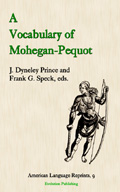
This title
qualifies for
a 10% discount when
ordered online
|
A
Vocabulary of New Jersey Delaware
by James Madison (1792)
Recorded in
the Indian village of Edgepillock in New Jersey in 1792, (modern-day
Indian Mills, Burlington County) these 267 words of the Southern Unami
dialect are taken from the papers of President James Madison as
reprinted in Henry Schoolcraft's Indian
Tribes . Also contains 76 entries Johannes DeLaet's 1633
vocabulary of the Sanhican Indians located north of Trenton, NJ which
somescholars believe is the only example of the Unalachtigo dialect of
Delaware.
2006 ~ 64pp ~ paperback ~ 978-1-889758-84-1 ~ $18.95
American Language Reprint Series, Volume 10
For a complete listing of volumes in the ALR Series, click here.
|

This title
qualifies for
a 10% discount when
ordered online
|
A
Vocabulary of Roanoke
by Thomas Hariot, John White and John Lawson
This volume collects all the extant data on the Carolina Algonquian
language. It contains words recorded by the now-famous Roanoke
colonists of 1585: 37 words from Thomas Hariot's Brief and True
Relation, 50 names of birds and fishes from John White's watercolors,
and 5 words from the discourse of Ralph Lane. Also includes the only
remaining sample of the Pamlico dialect, 37 words from John Lawson's
New Voyage to Carolina of 1709.
2006 ~ 51pp ~ paperback ~ 978-1-889758-81-7 ~ $17.95
American Language Reprint Series, Volume 13
For a complete listing of volumes in the ALR Series, click here.
|

This title
qualifies for
a 10% discount when
ordered online
|
Denny's
Vocabulary of Shawnee
by Ebenezer Denny (1786)
This
vocabulary is a substantial collection of 404 Shawnee words and phrases
collected by Major Ebenezer Denny in January of 1786. It was compiled
from Shawnees assembled for treaty at Fort Finney, located along the
Great Miami River in the southwestern corner of Ohio, mostly from a
woman called "the Grenadier Squaw."
2006 ~ 51pp ~ paperback ~ 978-1-889758-65-5 ~ $17.95
American Language Reprint Series, Volume 14
For a complete listing of volumes in the ALR Series, click here.
|
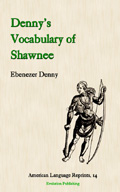
This title
qualifies for
a 10% discount when
ordered online
|
Cummings'
Vocabulary of Delaware
by Richard W. Cummings (1852)
Nearly 350
words of the Southern Unami dialect of Delaware or Lenape make up this
vocabulary which first appeared in Henry Schoolcraft's History, Condition and Prospects of the
Indian Tribes of the United States. It was recorded in 1852 most
likely on the Kansas reservation just north of the Kansas River. The
expanded 2006 edition also contains an additional 200 words taken by
Lt. Amiel Weeks Whipple on the Kansas reservation from the noted
Delaware chief Black Beaver in 1853.
2006 ~ 74pp ~ paperback ~ 978-1-889758-82-5 ~ $18.95
American Language Reprint Series, Volume 15
For a complete listing of volumes in the ALR Series, click here.
|
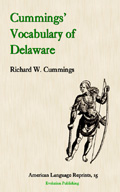
This title
qualifies for
a 10% discount when
ordered online
|
Cummings'
Vocbulary of Shawnee
by Richard W. Cummings (1852)
This
vocabulary draws from a questionnaire prepared by Henry Schoolcraft and
was subsequently published in his Indian
Tribes (1851-1857). It was collected by U.S. Indian agent
Richard W. Cummings, probably from the Shawnees of Kansas.
2009 ~ 47pp ~ paperback ~ 978-1-889758-95-4 ~ $17.95
American Language Reprint Series, Volume 21
For a complete listing of volumes in the ALR Series, click here.
|
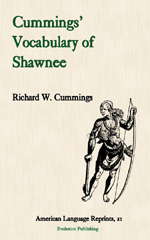
This title
qualifies for
a 10% discount when
ordered online
|
A
Vocabulary of Seneca
by Albert Gallatin (1820)
This volume
offers a list of over 400 words of the Seneca language compiled by an
anonymous collector in the War Department inthe 1820s. It also contains
an additional 89 words of Seneca derived from a manuscript of J. Parish
collected prior to 1820. Both of these were originally published in
Albert Gallatin's Synopsis of the Indian Tribes in 1836.
2009 ~ 75pp ~ paperback ~ 978-1-889758-96-1 ~ $18.95
American Language Reprint Series, Volume 22
For a complete listing of volumes in the ALR Series, click here.
|
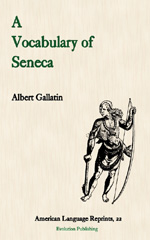
This title
qualifies for
a 10% discount when
ordered online
|
Wood's
Vocabulary of Massachusett
by William Wood (1634)
The earliest
substantial vocabulary of Massachusett was that taken by William Wood
and published in his New England's Prospect in 1634. It represents the
North Shore dialect of the language and contains over 250 words and
phrases in the now-extinct language. Included are the numbers up to
twenty, days of the week, months, and names of important people and
places.
2009 ~ 50pp ~ paperback ~ 978-1-889758-97-8 ~ $17.95
American Language Reprint Series, Volume 27
For a complete listing of volumes in the ALR Series, click here.
|
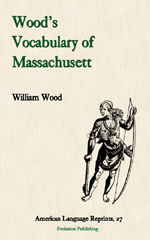
This title
qualifies for
a 10% discount when
ordered online
|
A
Vocabulary of Wyandot
by Col. John Johnson, Benjamin Smith Barton, et al. (1819)
This volume
contains 145 words of Wyandot collected by Col. John Johnston in 1819.
Johnston was an Indian agent and "beloved friend" who was associated
with the Wyandot and Shawnee tribes in Ohio for over 50 years. The
volume also includes a smaller sample of about 40 Wyandot words
collected by Benjamin Smith Barton in the late 18th century. Also
included are three sets Wyandot numerals collected by Conrad Weiser
(1755), William Walker (1851), and Samuel Haldeman (1847).
2009 ~ 45pp ~ paperback ~ 978-1-889758-98-5 ~ $17.95
American Language Reprint Series, Volume 30
For a complete listing of volumes in the ALR Series, click here.
|
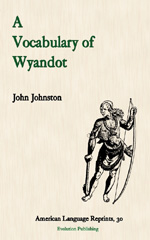
This title
qualifies for
a 10% discount when
ordered online
|
Castiglioni's
Vocabulary
of
Cherokee
by Luigi Castiglioni (1790)
This volume
features one of the earliest published vocabularies of Cherokee. It was
taken from Viaggio negli Stati Uniti
dell' America Settentrionale (1790), an account of the early
American Republic written by Luigi Castiglioni following his tour of
the United States. A Milanese gentleman and botanist, Castiglioni
recorded nearly 170 words in the Western or Upper dialect of Cherokee,
and this new edition is translated from the original Italian. The
volume also contains contemporary remarks on the language by the
naturalist William Bartram (1791) and includes a valuable list of the
names of 43 Cherokee towns which were inhabited during the 1770s.
2009 ~ 39pp ~ paperback ~ 978-1-889758-99-2 ~ $17.95
American Language Reprint Series, Volume 33
For a complete listing of volumes in the ALR Series, click here.
|
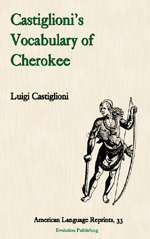
This title
qualifies for
a 10% discount when
ordered online
|
The American Language Reprint Series
Series Editor: Claudio R. Salvucci
At 30+
volumes and growing, the American Language Reprint (ALR) series aims
to compile and preserve the various Indian word-lists, vocabularies,
and phrase books which were collected during the
early years of North American settlement. These handy, small-format
books focus on the languages and dialects of the eastern woodlands,
with a primary emphasis on the Eastern Algonquian and Iroquoian
families.
Each ALR volume takes an original historical
word-list and alphabetizes the words in two sections, from the native
language to English and vice-versa. The original orthographies are
preserved exactly as they occur,
complete with all diacritics and special characters used by the
original authors. Several of these vocabularies have been edited and
annotated by some of the most prominent linguists
of the last two centuries, such as Daniel Brinton, J. Dyneley Prince,
and others.
|

Complete Listing of Titles
in the ALR Series
|
American
Languages in New France
Extracts from The Jesuit Relations
Compiled and edited by Claudio R. Salvucci
"A
fascinating book for anyone interested in Native American
languages
... an invaluable tool for historical linguists, anthropologists, and
ethnologists."
—Language
Magazine
This volume collects valuable fragments of
linguistic data and accounts of Native language as used among the
Algonquian and Iroquoian tribes of New France. It documents not only
observations on the languages themselves, but also on the mutual
intelligibility and geographical extent of various dialects, the
various pidgins and jargons that came into use
as a result of cultural contact, and the use of European languages such
as French and Basque in native North America.
Included as well are several extended tracts in
various Native American languages: Brébeuf’s 1636 description of
Huron grammar, Lalemant’s interlinear translation of a Huron prayer,
Vimont’s letter in
Algonquin, Le Jeune’s description of Montagnais, and many others. A map
showing
the location the missions and the approximate distributions of Native
languages is provided, as well as useful appendices including: a Native
language concordance of the nearly 1,600 terms mentioned in the volume;
a chart which compares the various observations about linguistic
relationships found in the extracts with a modern classification;
Nearly 100 brief biographies of Jesuits mentioned most prominently in
the text, extracted from the Thwaites edition..
2002 ~ 344pp ~ 3 appendices
~ map ~ hardcover ~ 1-889758-35-3 ~ $75.00
|

This title
qualifies for
a 10% discount when
ordered online
|
Handbook
of the Delaware Indian Language
The Oral Tradition of a Native People
by Scott Hayes Wenning
From the
time of William Penn through the French and Indian War, the Delaware or
Lenape played a major role in the events of the time. Using the 18th
century journals of the Moravian missionaries John Heckewelder and
David Zeisberger, this book pieces together information so that even
novices can understand basic Delaware speech. Complete with a brief
history, pronunciation guide, and grammatical key to using the Delaware
language, this book includes a 2,500 word vocabularly list, and a
step-by-step guide which makes learning the language fun and easy.
2000 ~ 124pp ~ paperback ~ 1-889037-23-0 ~ $16.95
|
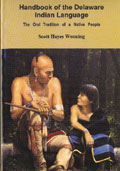
|
Evolution Publishing | Early
Indian
Language
Database | ACNA Series
| ALR Series
|

